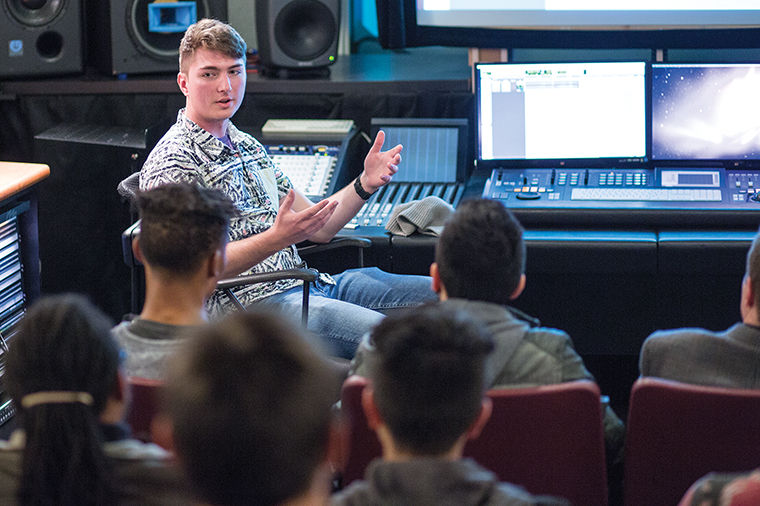New program combines music, science
Christopher Chraca, a senior in the Music Technology Program, showed prospective students what people in the program have been creating in their classes during an open house event on Nov. 9 in the 33 E. Congress Parkway Building.
November 16, 2015
The college’s graduation ceremony in May 2016 will include Columbia’s first student to graduate with a bachelor of science degree in music technology. The degree is granted through the recently established Music Technology Program, which the college approved during the Spring 2015 Semester.
The program hosted an open house Nov. 9 in the 33 E. Congress Parkway Building for prospective students, which featured faculty and current students who explained the program and shared student work from its courses.
Interim Director Howard Sandroff, along with faculty from the Audio Arts & Acoustics, Interactive Arts & Media and Music departments, officially proposed the Music Technology Program during the Fall 2014 Semester. It is designed to teach music composition in the context of computer science and audio-related technologies.
Sandroff said members of the departments had been working on the program for several years before its approval by the Provost’s office.
Because the program is interdisciplinary, most of its required courses were already offered at the college, Sandroff said during the open house presentation.
Students in the Music, Audio Arts & Acoustics or Interactive Arts & Media departments must apply to be admitted and have completed 45 credit hours, said Ben Sutherland, an associate professor in the Audio Arts & Acoustics Department who teaches in the program.
Prospective students spend their first two years at the college enrolled in a program in one of those three departments and work on the advanced degree requirements for the Music Technology Program after they are accepted.
“This program is designed with a high level of academic rigor,” Sutherland said. “It is admittedly not for everyone. [It is for] students who are interested in creating and influencing music technology.”
Senior Christopher Chraca will graduate from the Music Technology Program this spring. He said he had a class with Sutherland his freshman year that piqued his interest in the program.
“[The program has] all this high-level math and science and then art on top of it,” Chraca said. “[The program] blurs the lines between departments. It lets people explore things they probably would have never thought of.”
Each student is required to take four semesters of a program-specific course called the “Sonic Experience.” Each semester students will take three modules, each lasting five weeks, on different subjects taught by various faculty members in the program, Sutherland said.
There are currently four degree-seeking students in the program and they are hoping to add 16 to 18 students each year, Sandroff said.
Sebastian Huydts, an associate professor in the Music Department who has taught two of the modules on theoretical models and structure in electronic music and electro-acoustic orchestration, said the Music Technology Program is a great offering to students.
“Most music technology programs have either the technical aspect or the artistic part, and we aim to be a mix of both,” Huydts said. “Looking at the Strategic Plan for Columbia and the idea of making collaborative and interactive programming between departments [combining disciplines] seems like the right thing to do.”








